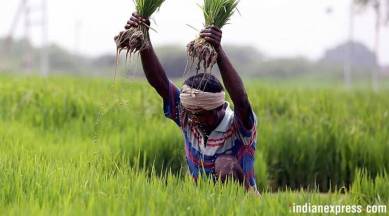Stay updated with the latest - Click here to follow us on Instagram
Paddy yield/ha dips 6kg in Punjab, show crop cutting experiments
Despite heavy rain and virus attack, 10 districts in the state saw increase in yield this year

After analysing the results of Crop Cutting Experiments (CCEs) of paddy, which was harvested in October-November this year, a drop of around 6kg has been witnessed in paddy yield per hectare (2.42 kg decrease per acre) in the overall average paddy yield of the state.
However, 10 districts have shown an increase in paddy yield this year.
Earlier, according to the initial results, which were analysed based on 70% CCEs, in November, an increase of 54kg per hectare was seen in paddy yield.
This year, several districts witnessed loss to the crop owing to heavy rain just before the beginning of paddy harvesting season which started on October 1. Also, the attack of the Southern Rice Black-streaked Dwarf Virus (SRBSDV) resulted in dwarfing of paddy plants in several districts.
According to the Punjab Agriculture Department, this year the average yield of paddy was 64.72 quintals per hectare (26.20 quintals per acre) against 64.78 quintals per hectare (26.22 quintals per acre) last year. A total of 2,084 CCEs were conducted across all districts.
According to the results, a dozen districts recorded a fall in the yield, including a half dozen districts recording a huge decline between 14% to 23% in the average yield.
District with a huge reduction in the yield this year included Pathankot, Fatehgarh Sahib, Hoshiarpur, Mohali, Roop Nagar, Nawanshahr all with huge drop, and the remaining six districts Jalandhar, Ludhiana, Bathinda, Amritsar, Gurdaspur, Muktsar Sahib recorded one quintal to over 3 quintal loss in yield per hectare.
Pathankot recorded a loss of 12.1 quintals (23%) per hectare as the district recorded 40.51 hectares yield per hectare against 52.61 quintals last year, Fatehgarh sahib, which recorded 60.38 quintals paddy yield per hectare against 70.37 quintals last year witnessed a decline of 10 quintals per hectare (14% reduction in the average yield of paddy in the district), Hoshiarpur recorded 46.93 quintals yield per hectares against 56.67 quintals last year, a loss of 9.74 quintals per hectare (17% less), Mohali recorded a loss of 8.75 quintals per hectare as 43.49 quintals yield was recorded against 52.24 quintals last year, a loss of 16.74%, Roop Nagar recorded 54.39 quintals yield per hectare against 63.08 quintals last year, a loss of 8.69 quintals (13.77%) per hectares, and Nawanshahr recorded 58.86 quintals per hectare against 67.36 quintals last year, a loss of 8.50 quintals (12.6%) drop in the yield per hectare.
The districts which recorded high yields this year compared to last year included Barnala, Ferozpur, Fazilka, Sangrur, Tarn Taran, Patiala, Moga, Mansa, Kapurthala, and Faridkot.
The maximum yield was recorded at Barnala where 78.03 quintals yield was procured per hectare against 70.81 quintals last year. The district has not only recorded the highest yield among all the districts but also witnessed around 14 quintals more than the state’s average yield this year.
The district recorded a hike of 7.22 quintals (10%) per hectare, Fazilka recorded 5.75 quintals (12.26%) per hectare more by getting 52.65 quintals yield per hectare against 46.90 quintals last year, Ferozpur recorded 71.40 quintals per hectare against 65.76 quintals last year, an increase of 5.64 quintals (8.5%), Moga recorded 4.50 quintals (6.36%) increase by recording 75.23 quintal per hectare against 70.73 quintals last year, Tarn Taran recorded 2. 68 (4.5%) quintals more per hectare with receiving 62.05 quintals per hectare against 59.37 quintals last year, Mansa recorded 70.26 quintals per hectare against 68.20 quintals last year, an increase of 2.06 quintals per hectare (3%), Patiala recorded a gain of 1.82 quintals (2.82%) by getting 66.20 quintals per hectare yield against 64.38 quintals last year, Sangrur recorded 1. 54 quintals (2%) more yeild per acre by obtaining 76.94 quintals per hectare against 75.40 quintals last year, and Kapurthala recorded 45 kg increase per hectare (0.7%) with 63.42 quintals yield per ha against 62.97 quintals last year.
Dr Gurvinder Singh, director of Punjab Agriculture department, said, “These estimates of paddy yield are based on the crop-cutting experiments analysed in each district. The attack of the virus on paddy crops in various districts of the state mainly in Pathankot, Hoshiarpur, Nawanshahr, Ropar, Fatehgarh Sahib, Ludhiana, Jalandhar, Mohali etc. and heavy rains just before the harvesting has affected the yield. Due to the attack of the virus, the growth of paddy plants in several fields stopped after 40 to 50 days of sowing. And such stunted plants were uprooted by farmers then and there .”